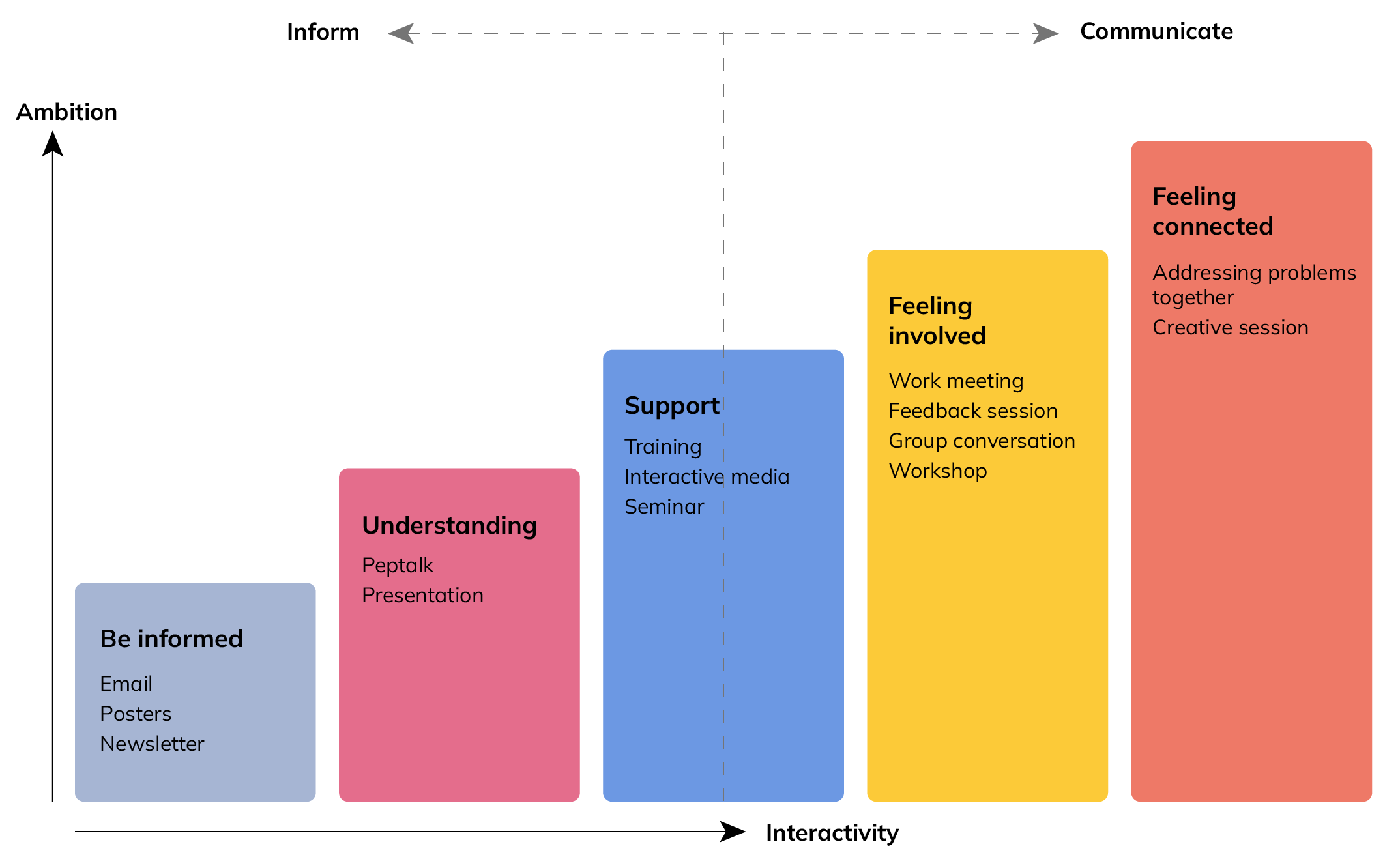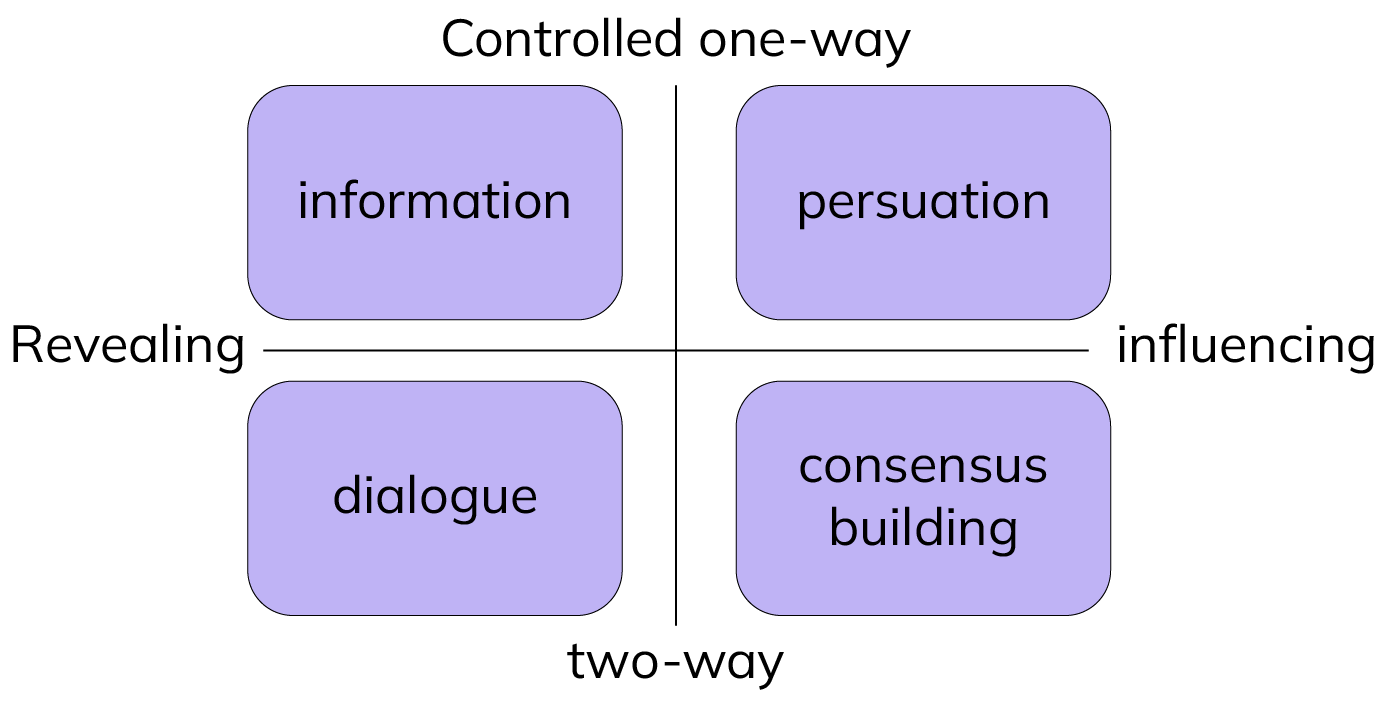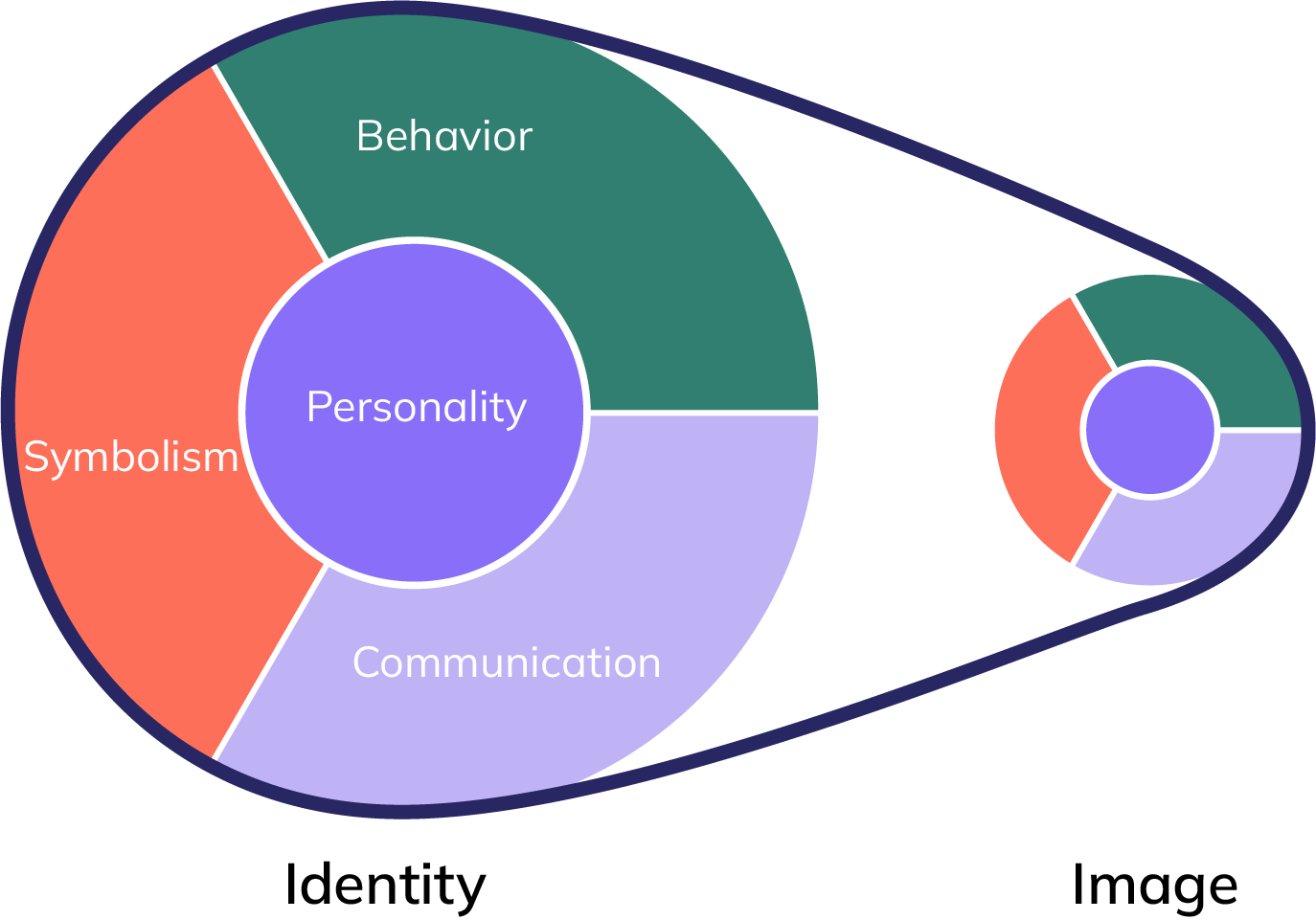What is internal communication?
Internal communication is the dynamic flow of information within an organisation. It extends beyond the official messages that your organisation delivers to employees. It's like the heartbeat of an organisation, where team members collaborate smoothly and engagingly, share ideas, and strengthen the company culture. requires effort.Why is internal communication so important?
You want to share information with staff, make your colleagues successful in their roles, and involve them in your organisation. Good internal communication leads to increased engagement, which translates to higher productivity, increased revenue, and reduced staff turnover. Your customers also benefit from good internal communication. Building this engagement requires effort.However, employee loyalty isn't something that just happens automatically. People want to feel understood and treated fairly. They want to be well informed about what matters to them. Strong internal communication is the glue that holds your organisation, colleagues, and departments together.

Approach your internal communication like you do with the rest of your marketing
Let's be honest. We've all seen high-level and corporate newsletters packed with jargon and massive blocks of text that we won't read. However, if done right, internal communication has the power to inspire, build culture, and align teams.You should approach your internal communication just like you do with your external communication: with a thoughtful strategy and across various communication channels. As you know, each channel has its own characteristics, and a message sticks through repetition.
Examples of internal communication tools
The choice of tools for your internal communication is quite extensive. It's important to find the right combination of tools for all employees, your organisation, and goals. Below, we delve deeper into various communication channels, software, and their pros and cons.Whatsapp, Teams, Slack
And all other apps falling under instant messaging. It allows your colleagues to communicate very quickly and casually.However, for your employees, it can be time-consuming, and not everyone feels comfortable being thrown into a group conversation. Moreover, it's easy to get lost in the flood of messages, causing important ones to be ignored. Additionally, there are privacy concerns.
An employee app
There's an increasing number of software on the market designed exclusively for your internal communication. Often, these also include tools for vacation or sick leave requests, accessing pay stubs, and sharing messages.It's super convenient but yet another place where your employees have to log in. If you exclusively use such a tool, you'll likely need to invest a lot of time and effort in onboarding people and motivating them to open the tool regularly. Especially when you're still actively building that engagement. So, don't use it as your sole communication channel for internal communication and be present where your employees are every day - or log in.
Email marketing
Email is the easiest channel to reach all your employees simultaneously in software they use daily. Additionally, you can specifically send targeted information to the right audience. You can easily link to external resources, reading material, or media. Moreover, through profiling, you can gauge which topics interest your employees the most.Social media and blogs
Social media channels seem convenient at first glance for disseminating messages. They're also free. But you quickly encounter algorithms and privacy issues. You're asking your employees to use their personal channels for work-related communication. Moreover, the information is incredibly transient.On the other hand, a blog is suitable for delving deeper into important news and linking to it. An intranet, however, is somewhat outdated and is increasingly being replaced by an employee app. This also applies to notice boards.
Team meetings and gatherings
Team meetings naturally belong in your internal communication. You can't rely solely on digital communication for your entire internal communication. Face-to-face contact and interaction, even if digital, are essential to effectively convey your internal communication.
Surveys
Surveys among your employees are valuable additional tools to gather feedback. Ask engaged employees to really consider your culture, operation, and communication. Use that feedback to refine your approach further.Planning or project tools
Your people need to know how a project is progressing and how they contribute. This avoids miscommunication and allows your employees to work efficiently. However, don't forget to share successes, even with colleagues not involved in the project. Use other instruments and tools to celebrate such successes, thank your team, and let colleagues be proud of their work.Notice boards and posters
If you have physical locations, busy places are ideal for repeating certain messages. Think of registrations for staff parties, closing days, events, important appointments, or deadlines.What are internal communication models?
If you prefer starting from theory and proven models from communication sciences, below are 4 leading models highlighted and how they specifically apply to internal communication.Quirke's Ladder: change processes with concrete resource deployment and milestones

Quirke's Ladder, consisting of six levels, illustrates a gradual buildup of communication within an organisation. Quirke's Ladder is particularly used for effective internal communication during change processes. Starting with basic information at the first level up to strategic, in-depth insights at the sixth level, the ladder offers a structured approach to disseminate and receive information, moving from "knowing" to "connecting." This can also support enhancing the communication skills of your employees.
In internal communication, this ladder can be utilised to ensure that the right information is shared at the appropriate level, contributing to more effective collaboration and engagement. It also allows you to gauge at which phase of the change process your employees are and where adjustments might be necessary. Another highly useful communication model during changes and challenges is the ADKAR model.
Laswell's communication model to map your internal communication flows

In 1948, the American psychologist and sociologist Harold Lasswell developed a communication model still frequently used in communication science. Lasswell's model, posing five crucial questions - "Who says what, through which channel, to whom, with what effect?" - provides a succinct framework for internal communication. Identify the sources of information, the messages being conveyed, the channels used, the target audiences, and the intended impact.
When Lasswell developed the communication model in 1948, it was intended to study the media propaganda of countries and businesses. At that time, only the wealthier had access to mass media such as television and radio. However, within your internal communication, this model can effectively help map your communication flows accurately and align your messages and expectations with your target audience. This results in a more effective transfer of information.
Ruler's Communication Intersection: does your audience already have an opinion or not?

Betteke van Ruler's Communication Intersection is based on the premise that your way of communicating cannot be the same for every situation. By following this model, you ensure that your communication truly resonates with the recipient. Depending on the situation, you choose to inform, persuade, engage in dialogue, or engage in co-creation. The key lies in whether your message is already fixed and whether your recipient has already formed an opinion.
Birkigt and Stadler's Identity Model: the DNA of internal communication

The Identity Model focuses on an organisation's identity and image. According to Birkigt and Stadler, an organisation's image and therefore its reputation reflect its identity. This identity comprises 4 elements: symbols, communication, behavior, and personality.
Behavior encompasses all daily actions, representing your internal communication, both formal and informal, conducted daily. Think about interactions with employees and customers, responses on social media, etc.
Communication ensures the organisation's personality is conveyed. This communication must align with the behavior of your organisation, management, and employees.
Symbols pertain to the images you use, such as the visual identity, colors, logo, and campaign visuals. Employing strong symbolism can differentiate you from competitors.
All of this emphasises how crucial identity and consistency are for both internal and external communication. This is the only way to authentically engage with your team and customers.
How to create an internal communication plan?

Is internal communication crucial for your organisation? Then, you need a robust internal communication plan. To do this, think like a marketer. Start internally and gather insights from your employees, providing them with a voice and collecting new perspectives.
Ask yourself the following questions:
- What is my current strategy?
- What role does communication currently play within my organisation?
- How do my employees evaluate that communication?
- What works? Where is improvement needed/possible?
- Which messages have had a lasting impact in the past?
Tips to enhance internal communication
You're already communicating, but these tips can improve your internal communication:Understand your employees
Factors like age, job group, location, and cultural aspects significantly influence how you package your internal communication. But also consider interests, language, and media usage in your channel choices. From there, you can create internal target groups.Consciously tailor your communication to all these details. Show that you genuinely act on your employees' contributions and provide transparency in that process.

Comprehend what works and what doesn't
Your internal communication fails when there's a lack of compelling messages. Ask yourself - and your employees - the following questions:- What are their struggles?
- What information do they need to perform their jobs well?
- What do they want to know about colleagues and other teams?
- What practical information do they require?
- Are there specific concerns or uncertainties?
Communicate transparently, regularly, and timely
Nowhere is everything smooth sailing. Sometimes, there's a need for reorganisation, adjusting procedures, dealing with a loss or bereavement, losing a crucial client, or, for instance, clearly communicating COVID measures.No matter how many times you say something isn't a concern among the people or that something is confidential: do not underestimate how swiftly news spreads within your organisation.
Whether it's pleasant or less pleasant communication, inform your employees promptly about developments, even if you don't have all the details yet. A provisional update is better than no news at all. Also, allow people space to react, let off steam, or present ideas.
Avoid prolonged periods without communication and provide regular updates to maintain the connection with your employees. Consistency is paramount in improving internal communication.
Strategically utilise your channels
How will you blend these channels for your internal communication, and how precisely will you use each channel? Communicate this and stick to your decisions. This way, your employees will clearly understand what to expect.For example:
| Planning tool | Internal wiki | Organisational app | Email marketing |
|---|---|---|---|
| Work schedules and team allocations | Project briefs Meeting summaries Blog articles | Vacation plans Celebrating successes Quick, brief updates for important news Links to blog posts | Swift updates and news summaries Monthly newsletter with key news highlights and personal news, such as births and contests Invitations for actions, training, team-building, parties |
Consider the right content mix
You need a balance between crucial messages and light, enjoyable information. This keeps people engaged and informs them about essential news required for customer assistance. Support your internal communication with visuals for a personal touch.Thus, even for your internal communication, you require a content calendar and aim for a good frequency. However, remember that your plan isn't set in stone: less critical matters always yield to news crucial for your employees.
The 360-degree approach
For your message to stick, it needs repetition. From marketing, we know that an advertisement is noticed after 6 to 11 viewings. In your internal communication, you must apply a similar principle.Convey your message using packaging suitable for each medium. This makes your employees feel that the theme is present throughout the organisation, enhancing engagement and trust.
Internal communication trends
Certainly, trends in internal communication can evolve, especially influenced by technology and the needs within your organisation. Below, we'll briefly discuss some internal communication trends:Digital collaboration tools: Increasingly, digital platforms like Slack, Microsoft Teams, and other employee software are emerging. These offer intriguing new possibilities for internal communication, which you must assess for fitting into your channel mix and organisation.
Video: There's a growing use of video, including webinars, onboarding videos, and other training materials. Particularly helpful for remote or dispersed teams to establish a personal connection with each other and the organisation.
Employer branding: Employees are leveraged as ambassadors, encouraged to share your company news on their social media channels. To do this successfully, you need a strong corporate culture and ensure that employees take pride in working for your organisation.
Chatbots and AI: Integrating chatbots to enhance internal communication and address common queries.
Rise of employee engagement platforms: Tools to measure engagement through surveys, feedback mechanisms, and performance data.
Podcasts: Internal podcasts can also be an excellent way to convey information, updates, and stories in a more dynamic format.
Inclusive communication: Focus on creating communication accessible to everyone and diverse. Consider the needs and perspectives of all your employees.
Gamification: Incorporating game elements into your internal communication to make training, learning, and information sharing more engaging, playful, and interactive.
Virtual reality and augmented reality: Especially interesting for training and development, considering your internal communication strategy.
The role of email marketing in internal communication
Thoughtfully utilised, email marketing can be a valuable part of your internal communication. When managed effectively, email marketing can create engagement, loyalty, satisfaction, and clarity within your organisation.Every message has its place
Need to swiftly convey information to everyone within a target group? Use email. It enables you to concisely deliver the key points. For more information, you can refer, for example, to your employee app.Regular summaries and recaps
Provide a monthly newsletter to summarise your key HR news again because repetition is crucial. For instance, you can:- Keep everyone informed about interesting projects
- Provide updates on traffic disruptions
- Introduce new employees
- Share the agenda
- Solicit opinions
- Check if people understood meeting points
- Encourage employees to share vacancies via social media
- Launch contests
It starts with a professional email marketing system
Internal emails are still too often sent via Outlook. Yes, the mail has left your inbox. But that's all you know. Did it pass through the spam filter? Did people open the mail? Was there any interaction with the content?Through a professional mail platform, you can segment target groups, streamline work, present your emails attractively, personalise content, mestablish measurable objectives for your organisation, and evaluate campaigns and results.
Customer case
Discover how Wilms handles internal communication
To effectively handle internal communication, you should start with your employees. What concerns them and what do they need? Based on that feedback, optimise the interaction between your various channels.

Would you like to try Flexmail?
Design mails tailored to your needs, reach your target group, and learn from the proper results.
Get a free trial now Michelle Dassen
Michelle Dassen


